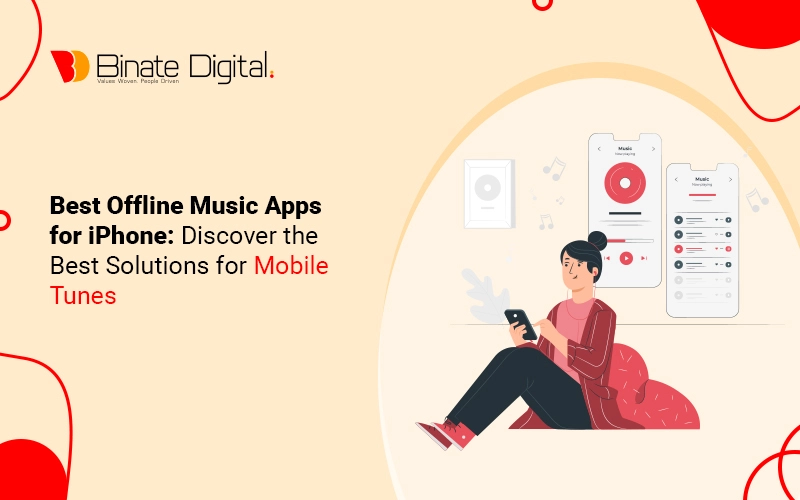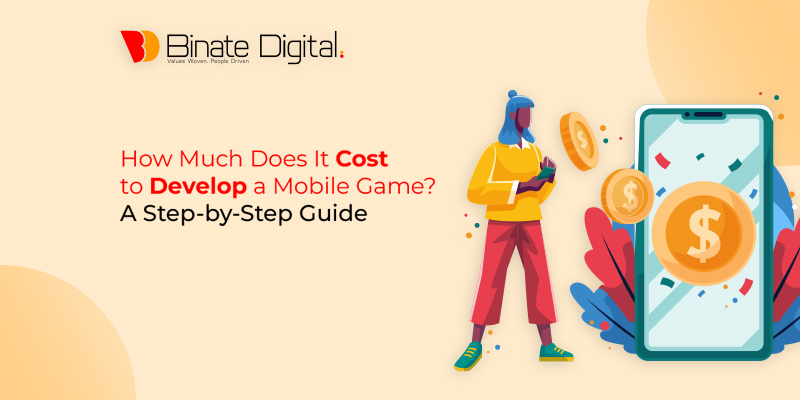Mobile game development has taken the gaming industry to its peak, and with the ever-growing number of smart devices, the market for mobile games is escalating rapidly. Developing a triumphant mobile game demands a smartly arranged execution of the development process, beginning from conceptualization to launching the game on app stores. In this article, we will discuss the critical steps involved in the process of mobile game development, from making a game plan to uncovering equitable mobile game development software and launching your mobile game. We will also look into the significance of funding in mobile game development, the budget involved, and the leading mobile game architectures accessible to game developers.
On this Article
How Do I Get Started With Development?
If the question ‘how to make a mobile game’ arises in your head, then here is the answer to your question: Developing a mobile game is definitely an intriguing and thrilling process that needs thoughtful groundwork and implementation to assure the success of the mobile game. Many steps are involved in the development process of a mobile game. And having a major understanding of it can help a developer come up with a high-quality game that the players will enjoy playing. Every stage of mobile game development needs keen attention to detail and an extensive understanding of the mobile gaming industry, from making plans to launching your game on app stores. We will discuss the main steps in developing a mobile game and give information about the resources and tools required to develop a successful game.
Every mobile game development company has its own process for mobile game development, but most productions will follow a set of standards. Following is the basic process of mobile game development that most developers follow:
Idea
Having a great game idea is certainly accommodating when it comes to game app development, as it can bring forth solid principles for the game’s concept and overall design. However, having a great idea alone is not enough to ensure the success of the mobile game. The mobile game app needs an amalgamation of creative, technical, and business skills to bring an idea to life and make it successful. This involves designing occupying gameplay mechanics and creating high-quality graphics, sound effects, and more stuff we will learn in detail.
Moreover, user reviews and market research play an important role in evaluating the success of a mobile game. This means that even if you have a great idea for a game, it’s important to observe it with potential users and collect reviews to make sure that it resonates with your target audience and has the capability to be successful in the market.
Story Matters
We, as humans, are used to looking for stories everywhere we go. Since we are developing games for humans, stories should be your game’s primary interest. Think of games like Fruit Ninja; players enjoy playing them, but they cannot keep them occupied for hours. They will surely think of changing to another gaming activity, as swiping left and right will not make them stick to it for hours.
So, while you are at the early stage of groundwork, hire mobile game developers to keep you in the loop on this. Make sure to come up with innovative storylines and shortlist the best. After detecting it with random players, implement it in your game development process.
Make a Game Plan
Improper planning or a lack of planning can make or break your game. Before you start developing your first game, you need to know what type of game you want to develop. Take as much time as you need to pen down ideas, come up with different characters, play with different art styles, and think about the kind of gameplay that would make your game intriguing and different. Once you have finalized the genre, make sure you sketch out and describe in writing how you want your game to be after its development is complete. It doesn’t have to be extensively detailed. Noting the points in a notebook that narrates a few things about how you want to make a mobile game will help you stay focused as you develop your game.
Find the right mobile game development software
Why make a mobile game more difficult than it should be? Take advantage of the growth in development tools that do the coding for developers so they can emphasize the more innovative side of your creation.
- Unity:
This is, without a doubt, the most commonly used software among mobile game developers. It is absolutely free to use and has very high graphics.
- Development Kit powered by Unreal Engine:
This comes with a ready-made basic project, so you can enjoy and practice developing a prototype game to acquire knowledge about the tool sets.
- GameSalad:
This certainly needs no coding knowledge but utilizes what they call a “behavior-based logic system.” Think of it as a drag-and-drop game developer. Of course, there is still a cognitive style, and you won’t be developing difficult games as soon as you open them. However, it is no doubt a powerful tool that can launch games on all platforms, like Android, iOS, and Windows, with just a tap on the icon.
Creating a Game Wireframe
A wireframe is a linear representation of the basic configuration and performance of a game’s menu-driven interface or a level’s layout. It is usually produced during the mobile game design process to visualize the game’s interface or level of design.
A wireframe is an uncomplicated version of the final design and usually consists of basic shapes, lines, and text without any actual visual assets or graphic design elements. It gives a framework for the game’s interface or level layout, showing the positioning of several factors, such as buttons, text boxes, menus, and interactive elements, and their relationships.
Game wireframes are meaningful for identifying potential issues with the game’s design and enabling changes to be made early in the development process. They are also accommodating in communicating the design and vision to the development team, stakeholders, and other members of the development process.
Learn your programming language
It doesn’t matter which game development software you choose. Adapting a programming language is still extremely important. A good place to begin is C#, which is the most widely used programming language among Unity developers. C# is a target-oriented programming language that is effortless to adapt. Python is another accepted language for mobile game development. Among Python’s many benefits is a rich variety of libraries to help bring your mobile game to the next level.
Beginning your mobile game development project
While genuinely beginning your project can feel intimidating, keeping things easy means you can get the outcome quickly. Let us review the process of the mobile game development project:
- Begin with the basic mechanics and rules of play.
- Design your first level, execute your graphics, and test.
- Lastly, create the confluence (screens, menus, options, etc.).
Execute mobile game graphics
The drafting stage is when you decide whether the game will have 2D or 3D graphics. When you’re ready to implement them, you must decide whether you want to do the graphics work yourself or hire a designer. You can create lucrative characters with the talent of graphic design by yourself with Photoshop, which can be used for 2D graphics; Maya; or 3ds Max, which can be used for 3D graphics. Externalize your representations to another designer. Numerous sites are assigned to cater to you, and you hire a designer who will give you the look you want.
Elevate your play
You need to cleanse the game for the purpose of developing a fun and unforgettable experience once your game is set up. Here are some common tweaks that will ensure your game is well-received by players:
- Ensure your game doesn’t pixelate.
- Make the controls easy and intuitive.
- Add an interesting and engaging storyline.
- Change the mood through music that is pleasant and not disturbing.
- Test, test, and test some more.
Test Your Game
Now that the development phase is complete, it’s high time to get it observed and analyzed for bug fixes. You can test the mobile game by launching the beta version and playing it on different devices. As a result, you will find various bugs that can be fixed, so your game can be developed to perfection.
Releasing your mobile game
A mistake that new game developers often make is putting extra effort into making the game perfect, thus holding up the launch of the game. Make sure to complete testing and refinement, but know that it’s better to get the game out the door quickly. Once your target audience is engaged, that’s when feedback is received. With the help of feedback, a gaming app can be upgraded easily. You will need a budget for marketing your game on different platforms if you are really into making money off of it. You can also send your game for analysis to Mobile Startupz or Android Guys. You’re going to want to submit your app to a platform like Apple or Google Play to launch your games. The links involve important details from these platforms about how to submit your apps.
Why Should You Invest in Mobile Game Development?
As per SensorTower, the mobile gaming industry is expected to make $138 billion by 2025. According to Statista’s report, mobile game apps’ revenue is predicted to show an annual compound growth rate (CAGR 2023–2027) of 7.36%, which has resulted in an expected market volume of US$419.70bn by 2027. Potential revenue from mobile gaming is increasing rapidly and becoming quite profitable. Hence, you can consider funding mobile gaming to take your company to the next level. So, these are the most common insights about current market metrics and future mobile game development industry predictions.
Are You Planning To Develop A Game Application? Let’s Learn About The Kinds Of Game Applications
There are different types of games. You need to decide what your type is, and based on that, you can proceed with mobile game development. Here we have executed four key types of games to help you decide:
Casual Games
Casual users are used to spending irregular time periods ardently occupied in the game. These kinds of games can be created in any genre; their market is comparatively larger. Usually, such games are developed with less complicated rules and a simple tap-and-swipe interface; Candy Crush and Subway Surfers are prime examples. The audience of casual games is generally larger, and the number of casual game downloads is much higher than that of other kinds of games.
Mid-core games
Mid-core games are more complicated than casual games from the perspective of production, character development, and overall gameplay. In such games, players must put extra effort and commitment into the game. As game development companies are generating a good amount of revenue from mid-core gaming applications, we expect it to continue to be one of the trends in game apps.
Hardcore games
Hardcore games are for gamers who don’t consider games just a hobby; they are serious gamers. Think of gaming ideas that are more or less like God of War Ragnarok, Loot River, Stray, Suicide Squad: Kill the Justice League, and many more because they are typical hardcore games. The audience for this kind of game category is generally youth, who spend longer periods incessantly playing games. As these games are more engaging and take more time to clear the game’s levels and win quests, they are highly engaging to the players and have gained recognition in terms of being interesting games.
AAA games
AAA is a high-budget game, and it demands a full-time, committed team to work on it and produce such games. Similar to hardcore games, they, too, call for ample time and commitment to get the hang of it. As of now, AAA games have been launched only for games that can be played on PC and can be used as console games. As smartphones and data streaming are still not well-suited for game categories like AAA, we will soon see bigger game titles released for mobile gaming. The above-mentioned were the most important categories of games. Games are generally divided into those four categories. Now let us get to know more about segments that will help you develop a game.
The Most Suitable Monetization Strategy
Here we are presenting the five most commonly used and workable game app monetization strategies. Let’s take a look:
In-app Purchases
This is one of the most famous monetization strategies for game developers. In-app purchases enable players to purchase virtual goods, power-ups, and other characteristics that improve their gameplay experience. By offering these virtual goods, game developers can profit from players’ willingness to pay for additional benefits and features.
Subscriptions
Game developers can offer players a subscription model that unlocks additional features or content. Players pay a fee regularly, typically monthly or yearly, to get these benefits.
Pay-to-download
In this app monetization strategy, players pay a one-time fee to install the game app. This strategy works fine for games that have a high perceived value or are part of an official franchise with a boundless fanbase.
Crowdfunding
Crowdfunding is the latest monetization model that enables game developers to collect funds from their fans and supporters to develop and launch a game. Crowdfunding platforms like Indiegogo or Kickstarter are famous for helping game developers obtain early funding.
Advertising
Advertising is another popular game app monetization strategy. Developers can generate revenue by displaying ads within their games. They can use various ad formats, such as banner ads, interstitial ads, or rewarded ads. With rewarded ads, players are rewarded for watching an ad, which can effectively monetize a game app without disrupting the gameplay experience.
6 Common Mistakes to Avoid in Mobile Game App Development Process
Let’s learn about mistakes that are commonly made during the process of game development:
1. Inadequate planning
Lack of proper groundwork can result in delays, cost massacres, and a subpar final product. It’s essential to come up with a detailed project plan defining every aspect of the game development process, including timelines, budgets, resources, and milestones.
2. Focusing too much on graphics
High-quality graphics are dominant in a game app, but they are not the only thing that matters. It’s important to emphasize developing engaging gameplay, designing a user-friendly interface, and creating interesting game features.
3. Ignoring user feedback
An app’s success cannot be measured without user feedback. Ignoring user feedback can result in a game that fails to attract and retain users. It is essential to keep an eye on the user’s feedback and enhance the gaming app with more advanced functionalities based on that feedback.
4. Overcomplicating the game
Keeping the game uncomplicated and easy to understand is vital, specifically for casual gamers. Overcomplicating the game with too many features or complicated gameplay mechanics can be profuse and distract users.
5. Neglecting game performance
When a game is optimized poorly, it results in low performance and gets stuck during the process. These glitches and non-smooth game performance can frustrate players. It’s important to optimize the game app for performance, including graphics, sound, and code.
6. Rushing to release
While it’s important to launch the game app quickly to capitalize on market opportunities, rushing to release can result in a subpar product that fails to attract users. Once the app is developed, there is no use in rushing to launch it. Instead, take time to fully assess the game’s app for any more glitches that might occur during performance.
How To Ensure The Financial Success Of My Game
Some things in life are guaranteed, but you can surely ameliorate the probability of your game’s success by following the tips and guidelines. We have discussed making the game interesting and unique, but hiring experienced developers is another important factor.
It is extremely important to allocate production to the best developers. They should have enough experience with similar projects and thorough technical knowledge that extends to all the software developers plan to use. With a genuine team of specialists, the project will be handed over within the expected time lapse and at the high level of standard that users expect.
If you do not have such specialists on hand or need compensation for delivering the project to completion, consider hiring a development partner.
What is Mobile Game Marketing?
In simple words, mobile game marketing promotes your game to get more players and earn more profit.
How to Market a Game
There are many different ways to promote a game and get more users. The two most common ways are paid and organic mobile game marketing, each of which has its own strategies.
Here’s what makes them different:
Paid marketing involves paid advertising campaigns on different ad networks. Organic mobile game marketing is a phrase that defines all free marketing strategies that can lead to attracting more users. Like posting game reviews and details on social media, maintaining its website, and optimizing the app store where you placed the gaming app.
Paid Mobile Game Marketing
To promote your game with paid advertising campaigns, there are three things you need to master. You need to understand your target audience, develop top-quality creatives, and discover how to advertise on dissimilar ad networks successfully.
Target Audience
The basics of any marketing strategy are recognizing and comprehending your desired audience. The same applies to marketing a mobile game.
Developers can’t simply target mobile game players because that’s a very large and diverse group. Next, you must determine the type of gamers you want to appeal to according to their motivation and fascination.
Player Motivations
Taking notes on the key features of the game is beneficial. For instance, consider a user-friendly casual match-3 puzzle game that incorporates design and decor meta elements. This description provides substantial insights into the target audience: casual gamers, puzzle enthusiasts, and those intrigued by design and decor.
We can extend even further. A player feels connected to the game when their cognitive skills are utilized by thinking, solving, and practicing the art of relaxation during leisure time. Thus, you can target players with these usual interests.
Creative Production
Now that you know how to identify your target audience, creative production is the next and most essential stage in a paid user acquisition strategy. It refers to creating innovative ads that will help you market your game. Video creative works best for mobile games and has the highest conversion rates. Creativity must be interesting enough and present the game in a good light to grab viewers’ attention and make them download it.
The Process of Creating a Video Ad
Creating a video ad involves market research, script writing, and creative production. Thus, the first step is to research and analyze competitors’ ads. You can start with Facebook Ads or use artificial intelligence platforms. Moreover, try to research more creative and engaging genres. Doing this gives you a better sense of what works and what doesn’t. Remember, top publishers meticulously test every creative, so if it’s working for them, there’s a big chance something similar will also work for your game.
Conclusion
A game is not just a game anymore when it becomes a part of our leisure time entertainment. We get to mark it on non-gaming-related products. It’s just not restricted to our mobile game applications. It lives with us. Whether famous game characters like Mario, Donkey Kong, Luigi Bal Hanuman from the Bal Hanuman game, Glenn from Chained Echoes, or Amicia from A Plague Tale: Requiem or acclaimed themes and soundtracks, a game becomes an important part of our l ives. But have you ever thought about what makes the game reach this level of fame and how much game apps make? It takes a lot of research and development, brainstorming sessions, innovative arguments, and a lot more stuff to get you on the path to a successful game.







